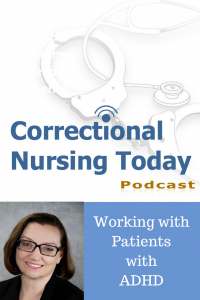 Marci Mackenzie, PhD, LCSW, and Marina Moshkovich, MD, join Lorry to talk about working with ADHD patients in prison. Dr. Mackenzie is a Clinician Administrator and Dr. Moshkovich is a psychiatrist with University Correctional HealthCare, Rutgers University Behavioral Health Care Division, working in the New Jersey Prison System. They presented a session on ADHD Prevalence and Treatment Among Prison Inmates at the NCCHC Spring Conference on Correctional Health Care in Atlanta April 29-May 2.
Marci Mackenzie, PhD, LCSW, and Marina Moshkovich, MD, join Lorry to talk about working with ADHD patients in prison. Dr. Mackenzie is a Clinician Administrator and Dr. Moshkovich is a psychiatrist with University Correctional HealthCare, Rutgers University Behavioral Health Care Division, working in the New Jersey Prison System. They presented a session on ADHD Prevalence and Treatment Among Prison Inmates at the NCCHC Spring Conference on Correctional Health Care in Atlanta April 29-May 2.
What is Attention Deficit/Hyperactivity Disorder (ADHD)?
Attention Deficit/Hyperactivity Disorder is a neurodevelopmental syndrome with a constellation of symptoms. The symptom pattern includes inattention, hyperactivity, and impulsivity.
- Inattention: Difficulty completing tasks, easily distracted, avoidance of activities requiring a sustained mental effort
- Hyperactivity: Acts as if driven by a motor, restless, internal tension
- Impulsivity: Acting without reflection or consideration of the consequences
While originally thought to be limited to childhood, ADHD is now considered a chronic condition that continues throughout the lifespan into adulthood. Signs of adult ADHD can include job failure, drug experimentation and dependence, and antisocial personality disorder.
Inmates with ADHD
Correctional populations are found to have two to five times more ADHD than the general population. A Colorado prison study reported adult ADHD in that setting was more prevalent than PTSD and major depression. It is currently estimated that at least 25 percent of US inmates have some degree of ADHD. The condition is often misdiagnosed as other condition such as depression or antisocial disorders. Inmates with untreated ADHD frequently end up in inmate fights and Administrative Segregation Units. The condition interferes with adjustment to incarceration and then reentry into the community.
Psychopharmacology Options in a Secure Setting
Many pharmacological choices for treating ADHD are problematic in a secure setting as they can be diversion targets. Here are some categories of options.
- Stimulants (Ritalin): Although the gold standard for treatment of ADHD in the general population, prescribing in prison is difficult due to a high abuse potential.
- Atomoxetine (Strattera): A norepinephrine reuptake inhibitor approved for ADHD treatment but cost prohibitive in the correctional setting.
- Antidepressants (Wellbutrin): Also high abuse potential but sometimes administered in a carefully controlled setting by crushing and dissolving in water.
- Clonidine and Guanfacine: Lower abuse potential and non-narcotic nature make these medications of particular benefit for the incarcerated population.
Therapy Additions
Behavioral therapy in conjunction with medication is recommended. The following interventions are recommended.
- Coaching and training in social skills and social cues
- Cognitive training to improve executive brain function
- Accommodations in learning situations such as smaller class sizes and use of visuals
A Team Effort
Correctional nurses have an opportunity to assist in the identification and treatment of ADHD. It is a team effort! Here are some ways to help.
- Look for ADHD symptoms during intake and other patient encounters
- Find out how to make a referral for evaluation in your setting
- Encourage medication compliance
- Consistent medication administration processes
Listen to this podcast to gain more tips for identifying and treating incarcerated patients with ADHD.
How about you? Have you worked with incarcerated patients with ADHD? Share your experiences in the comments section of this post.
Leave a Reply